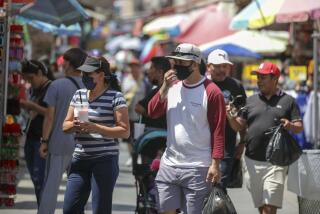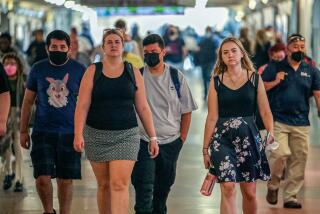California coronavirus-related deaths top 7,000 as infection spread worsens

The death toll from the coronavirus in California soared above 7,000 this weekend as the infection rate continued to worsen.
The rate at which coronavirus test results are coming back positive in California over the previous seven days has hit 7.97%. That’s the highest number since April — a continuing sign that the coronavirus is spreading throughout the state, according to a Los Angeles Times analysis conducted Saturday.
A week ago, on July 4, the so-called positivity rate over the previous seven days was 7%; and the Saturday before that, on June 27, it was 5.9%. The positivity rate in Los Angeles County is even worse than the statewide figure. On Friday, the seven-day positivity rate was 10% in L.A. County; in late May, that rate fell to a low of 4.6%.
As of Sunday morning, California had recorded 7,030 deaths and 319,000 confirmed cases. The coronavirus had exploded in the state over the last month as businesses reopened and people got back to old routines. In response to the surge, the state ordered bars and in-restaurant dining closed in many parts of California.
Hospitalizations have also spiked, and in the last week so have deaths. California’s death toll remain way behind other hot spots like New York (32,000) and New Jersey (15,000).
Los Angeles County health officials Saturday confirmed 2,916 new coronavirus cases and 57 more related deaths, as the region struggles with a surge of cases in the ongoing pandemic.
There are more than 2,000 people hospitalized with the virus, with 27% of those confirmed cases in intensive care and 18% on ventilators, officials said. It’s a significant increase from the 1,350 to 1,450 daily hospitalizations seen a month ago, according to the county Health Department.
L.A. County has identified 130,242 positive cases of the virus and seen a total of 3,793 related deaths. Officials have warned of the potential for exceeding hospital capacity if stricken patients have to start competing with others for a bed.
“For those of you mourning the loss of a loved one from COVID-19, your community mourns with you,” L.A. County Public Health Director Barbara Ferrer said in a statement. “We must work together to get back to being able to slow the spread. Unless we can do this, our recovery journey is in jeopardy.”
As of Saturday, the total number of coronavirus cases reported statewide stood at 316,928, with 7,016 related deaths, according to health officials.
Los Angeles is on the state’s list of counties being monitored for their rising case counts and increased hospitalizations. If counties remain on the list for three or more consecutive days, the state will require them to close bars and indoor dining in restaurants, along with most other indoor business operations, for at least three weeks. L.A. County reopened restaurants for in-person dining on May 29 and allowed bars to reopen on June 19. Its bars were ordered shut again on June 28, and indoor dining rooms on July 1.
During a Friday briefing, L.A. Mayor Eric Garcetti reminded Angelenos that socializing and gathering with people outside of their households is still not allowed. He warned — as he did earlier last week — that the city could reimpose a mandatory stay-at-home order should the risk of infection worsen.
“We’re not back to a safer at home order, but we all need to do our part to minimize the spread of COVID-19,” he said.
Twenty thousand people were tested at city and county testing sites Friday, Garcetti said. To meet surging demand, city testing capacity will increase by 25% this week. More than 1 million people have now been tested by the city and county, he said.
Meanwhile, health officials in the Bay Area in Northern California are sounding the alarm about rising number of coronavirus cases and have announced new control measures.
In Santa Clara County, officials are rescinding part of the region’s relaxation orders that were scheduled to take effect Monday. The county had initially planned to allow indoor gatherings of up to 20 people.
But officials on Friday decided against the move.
“Our county is at a critical moment,” Dr. Sara Cody, the county’s health officer, said in a video message posted Saturday on social media. “Right now, the numbers we are seeing aren’t going in the right direction….The number of people hospitalized with COVID-19 is growing every day.”
The county is, however, allowing hair and nail salons, massage parlors and gyms to reopen starting Monday. But officials said there are no plans to reopen bars or indoor dining rooms at restaurants for the foreseeable future.
In an interview with KPIX-TV that aired Friday night, the executive for Santa Clara County, Dr. Jeffrey Smith, urged state officials to take stronger action to halt the spread of the virus statewide.
“We really need the state to uniformly do something dramatic to stop the spread,” he said. Without stronger action, he feared the pandemic will soon be “spreading like wildfire.”
On Friday, hospitals in Santa Clara County reported 117 people with confirmed coronavirus infections in its hospitals; a week earlier, on July 3, there were 84; and the week before, there were 66.
In Contra Costa County, officials issued a new health order Saturday that will prohibit indoor religious services beginning Monday morning. Outdoor gatherings, including worship services and political protests, will still be allowed as long as mask and physical distancing rules are followed.
Contra Costa County officials said in a statement that more than 8% of its COVID-19 tests are now coming back positive over the previous seven days, “a sign that the virus is spreading rapidly in the county and that the community must take immediate steps to reduce the spread of the coronavirus and prevent our healthcare system from becoming overwhelmed.”
“Contra Costa is especially concerned about the risk of COVID-19 transmission in indoor gatherings, and in gatherings that involve removing face coverings for eating and drinking,” officials said in a statement. Health authorities say they are now “concerned that the number of patients needing intensive care could quickly exceed capacity.”
On Friday, there were 83 people in Contra Costa County hospitals; two weeks earlier there 42.
Officials in Alameda County said on Friday they had been informed by the state that outdoor restaurant dining there is no longer allowed and restaurants can only be open for drive-through, pickup or delivery service. Indoor restaurant dining has never reopened in Alameda and several other Bay Area counties.
More to Read
Start your day right
Sign up for Essential California for news, features and recommendations from the L.A. Times and beyond in your inbox six days a week.
You may occasionally receive promotional content from the Los Angeles Times.








